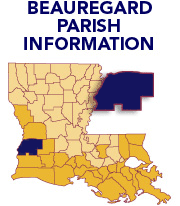Beauregard Parish - Disaster Impact and Needs AssessmentOverall, Beauregard Parish suffered moderate damage from Hurricane Rita, but damage to certain sectors was severe. Impacts from the hurricane were amplified because the parish’s economy is not strong and diversified; 12 percent of the population is over 65; 16 percent of the population is below the poverty level; local government capacity and infrastructure is limited; and a major percentage of the housing stock is sub-standard. The population is dispersed throughout the parish on farms and in six rural communities, and there were not enough accessible shelters available. As a result, many citizens and evacuees took refuge in local school buildings, which were not structurally adequate and lack emergency power and the other amenities needed to sustain large numbers of people for an extended period. A summary of impacts by sector follows: Economic and Workforce DevelopmentThe timber industry was hard hit, suffering severe damage in the southwest quadrant of the parish. Estimates place the total timber damage from Hurricane Rita at 1.5 billion board feet, primarily in five parishes including Beauregard, which is dependent on timber production. The LSU Ag Center estimates damage to timber in SOUTHWEST Louisiana at $227 million. A conservative assumption that Beauregard Parish experienced one-fifth of the total damage would result in Parish Losses of:
This loss has reduced the price of timber due to a short-term glut. In the longer term, it will affect the supply, and therefore job market. Futhermore, the debris has the potential to result in localized flooding, fires next summer, insect infestation and the growth of invasive species. Damage to commercial and business facilities resulted in:
Environmental ManagementBeauregard Parish enjoyed a relatively clean, pristine environment prior to Hurricane Rita. Most of the environmental damage was in the form of tree and vegetation destruction, debris accumulation, stream pollution, soil erosion, and visual degradation due to damage to signs, building exteriors, and architectural features. Some examples of this damage follows:
The damage to the timber crop has large economic development consequences for the parish as well as environmental impacts with a threat of increased flooding, insect infestation, and the spread of exotic species and forest fires. Human ServicesBeauregard Parish suffered substantial direct impacts to its citizens from Hurricane Rita, and from the evacuees traveling through or seeking temporary refuge in the parish. Some of the indicators of these impacts were:
It is difficult in normal times for residents of the rural areas to get timely health and human services due to a lack of public transit and local staff. The need to provide for evacuees meant that some resident were denied service. In summary, Beauregard Parish, though only moderately damaged by Hurricane Rita according to official reports, suffered severe damage to timber resources. The hurricane also caused considerable damage to basic infrastructure and economic capacity, and exposed serious weaknesses in the ability of the parish to withstand future disasters. Transportation and InfrastructureBeauregard parish served as a primary evacuation route for coastal areas in Louisiana and Texas, and as a result, highways, roads and basic support infrastructure were stretched beyond capacity. Street signs suffered about $20,000 in damages. Exacerbating the situation was the loss of electric power for over five days. As a result:
In addition to the traffic problems, all of the six public water utilities in the parish lost electrical power. Some of them had backup generators, others did not. Those without emergency generators experienced loss of water supply and overflows from their sanitary sewer systems. Boil-water orders were issued for those systems which lost pressure. Those which had backup power were forced to operate with fewer production facilities, some of which were damaged by continuous operation, and limited the available water supply. These emergency conditions exacerbated inherent problems in the water distribution systems. These piping systems are woefully undersized (e.g. 3/4 to 3 inches), constructed of obsolete materials, and most are approaching the end of their useful lives. The public was cut off from essential services, gas stations, grocery stores, etc, for longer than necessary due to the lack of generators. The entire recovery effort in Southwest Louisiana and Texas was hampered by the lack of backup power facilities at the Beauregard Airport. Normally, the airport can handle large jets for the delivery and marshalling of relief supplies and personnel, and has both rail and highway access. Housing and Community Development47 percent of the housing stock is over 35 years old, and dilapidated and run-down houses dot the landscape in the incorporated and unincorporated areas of the parish. Lack of land use ordinances, the absence of a coordinated parish-wide housing program, and the significant percentage of low income residents contribute to the continuing deterioration of the housing stock. Housing impacts from Hurricane Rita included:
Housing impacts were increased due to lack of building codes, age of housing stock many manufactured homes in rural areas, and lack of housing and neighborhood preservation programs. There is empirical evidence that there were many more structures that received damage than asked for public assistance such as the “blue roof” program. |







